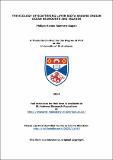Files in this item
The ecology of scattering layer biota around Indian Ocean seamounts and islands
Item metadata
| dc.contributor.advisor | Brierley, Andrew | |
| dc.contributor.author | Boersch-Supan, Philipp Hanno | |
| dc.coverage.spatial | xvi, 225 p. | en_US |
| dc.date.accessioned | 2017-08-14T10:54:25Z | |
| dc.date.available | 2017-08-14T10:54:25Z | |
| dc.date.issued | 2014 | |
| dc.identifier | uk.bl.ethos.722998 | |
| dc.identifier.uri | https://hdl.handle.net/10023/11440 | |
| dc.description.abstract | The waters of the open ocean constitute the largest living space on Earth but despite its obvious significance to the biosphere, the open ocean remains an unexplored frontier. With a regional focus on the Indian Ocean, this thesis investigates (i) the distribution of pelagic biota on basin scales, (ii) the effect of abrupt topography on pelagic biota and their predator-prey relationships, and (iii) the use of genetic techniques to elucidate population connectivity and dispersal of pelagic taxa. (i) Pelagic scattering layers (SLs) were surveyed with scientific echosounders across the southwest (SWIO) and central Indian Ocean to investigate their vertical and geographical distribution. Structurally distinct SL regimes were found across the Subantarctic Front, and may explain recently observed foraging behaviours of southern elephant seals. Regression models indicated a close relationship between sea surface temperature and mean volume backscatter, with significantly elevated backscatter in the subtropical convergence zone. The heterogeneous distribution of scattering layer biota may have implications for predator foraging and carbon cycling in the Indian Ocean. (ii) Acoustic surveys revealed diverse interactions between SLs, aggregations and topography around islands as well as shallow (<200m) and intermediate (200-800m) seamounts at spatial scales from 1 to 100 km. Epi-and mesopelagic backscatter was increased around reefs and banks of the Chagos archipelago, indicating connectivity between oceanic and neritic systems. SWIO seamounts harboured summit-associated aggregations, but the distributions of surrounding SLs did not follow a general pattern. Downstream SL depletion was observed in one location and combined with stomach content analyses, provides an insight into the mechanics of prey flux between open-ocean and seamount ecosystems. (iii) A mitochondrial marker was used to assess the population structure and demography of the hatchetfish Argyropelecus aculeatus in the SWIO. The results are suggestive of a single, well-connected population and indicate a recent population expansion around 0.14 million years ago. This highlights that even highly abundant mesopelagic populations are vulnerable to global climatic changes. Dispersal and recruitment are key ecological processes structuring seamount communities and are directly relevant for the management of exploited populations. Genetic barcoding was evaluated as a means to identify cryptic larval specimens of eels (leptocephali) and spiny lobsters (phyllosomata). Identification success was limited, but indicated the presence of 3-4 phyllosoma clades and 5-6 leptocephalus clades along the SWIR. | en_US |
| dc.description.sponsorship | "Additional funds came from the German National Academic Foundation, the Rehbock Fund, the Fisheries Society of the British Isles, and the Marin Alliance for Science and Technology for Scotland (MASTS) pooling initiative (Grants DSSG1 and SG98)." -- Acknowledgements | en |
| dc.description.sponsorship | Data collection in the Southwest Indian Ocean was undertaken as part of the Southwest Indian Ocean Seamounts Project (www.iucn.org/marine/seamounts) supported by the EAF Nansen Project, the Food and Agriculture Organization of the United Nations, the Global Environment Facility, the International Union for the Conservation of Nature, the Natural Environment Research Council (Grant NE/F005504/1), the Leverhulme Trust (Grant F00390C) and the Total Foundation. Shiptime in the Chagos was funded by the UK Foreign and Commonwealth Office." -- Acknowledgements | en |
| dc.language.iso | en | en_US |
| dc.publisher | University of St Andrews | |
| dc.subject.lcc | QH94.B7 | |
| dc.subject.lcsh | Marine ecology--Indian Ocean | en |
| dc.subject.lcsh | Seamount animals--Indian Ocean | en |
| dc.subject.lcsh | Plankton--Indian Ocean | en |
| dc.subject.lcsh | Elephant seals--Indian Ocean | en |
| dc.subject.lcsh | Oceanography--Research--Indian Ocean | en |
| dc.title | The ecology of scattering layer biota around Indian Ocean seamounts and islands | en_US |
| dc.type | Thesis | en_US |
| dc.contributor.sponsor | Cusanuswerk | en_US |
| dc.contributor.sponsor | Lesley & Charles Hilton-Brown Scholarship | en_US |
| dc.contributor.sponsor | Studienstiftung des deutschen Volkes | en_US |
| dc.contributor.sponsor | Rehbock Fund | en_US |
| dc.contributor.sponsor | Fisheries Society of the British Isles (FSBI) | en_US |
| dc.contributor.sponsor | Marine Alliance for Science and Technology for Scotland (MASTS) | en_US |
| dc.contributor.sponsor | EAF-Nansen Project | en_US |
| dc.contributor.sponsor | Food and Agriculture Organization of the United Nations | en_US |
| dc.contributor.sponsor | Global Environment Facility | en_US |
| dc.contributor.sponsor | International Union for Conservation of Nature | en_US |
| dc.contributor.sponsor | Natural Environment Research Council (NERC) | en_US |
| dc.contributor.sponsor | Leverhulme Trust | en_US |
| dc.contributor.sponsor | Fondation d'entreprise Total | en_US |
| dc.contributor.sponsor | Great Britain. Foreign and Commonwealth Office | en_US |
| dc.type.qualificationlevel | Doctoral | en_US |
| dc.type.qualificationname | PhD Doctor of Philosophy | en_US |
| dc.publisher.institution | The University of St Andrews | en_US |
This item appears in the following Collection(s)
Items in the St Andrews Research Repository are protected by copyright, with all rights reserved, unless otherwise indicated.

